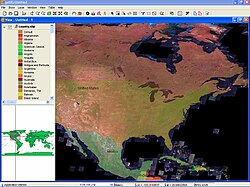This article has multiple issues. Please help improve it or discuss these issues on the talk page . (Learn how and when to remove these messages)
|
| gvSIG | |
|---|---|
| | |
 | |
| Developer | gvSIG Association |
| Initial release | October 2004 |
| Stable release | |
| Repository | |
| Written in | Java |
| Operating system | Windows, Linux, Mac OS |
| Platform | Java |
| Available in | CA, DE, EN, ES, EU, FR, GL, IT, PT,... |
| Type | GIS |
| License | GNU GPL |
| Website | www |
gvSIG, geographic information system (GIS), is a desktop application designed for capturing, storing, handling, analyzing and deploying any kind of referenced geographic information in order to solve complex management and planning problems. gvSIG is known for having a user-friendly interface, being able to access the most common formats, both vector and raster ones. It features a wide range of tools for working with geographic-like information (query tools, layout creation, geoprocessing, networks, etc.).
Contents
- Nomenclature
- Features gvSIG Desktop
- gvSIG Mobile
- Features gvSIG Mobile
- References
- External links
- OA Digital fork
- gvSIG Community Edition
- Integrating in the same view both local (files, databases) and remote data through OGC standards.
- Including a plugin system which allows to easily extend the application or to develop tailor-made solutions. [2] [3]
- Being open source software under the GNU General Public License (GPL), which allows its free use, distribution, study and improvement. [4] [5]
- Being available in several languages: Spanish, English UK, English USA, German, French, Italian, Portuguese, Portuguese-Brazilian, Russian, Chinese, Serbian, Swahili, Turkish, Czech, Polish, Romanian, Greek, Basque, Valencian/Catalan, Galician.
- Being developed using Java, and being available for Linux, Windows and Mac OS X platforms [6]